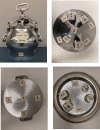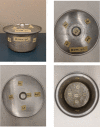Investigating aluminum cookpots as a source of lead exposure in Afghan refugee children resettled in the United States
- PMID: 35501355
- PMCID: PMC9119854
- DOI: 10.1038/s41370-022-00431-y
Investigating aluminum cookpots as a source of lead exposure in Afghan refugee children resettled in the United States
Abstract
Background: Afghan refugee children resettled in Washington State have the highest prevalence of elevated blood lead levels (BLLs) of any other refugee or immigrant population. Resettled families brought several lead-containing items with them from Afghanistan, including aluminum cookpots.
Objectives: To evaluate the potential contribution of lead-containing cookpots to elevated BLLs in Afghan children and determine whether safer alternative cookware is available.
Methods: We screened 40 aluminum cookpots for lead content using an X-ray fluorescence (XRF) analyzer and used a leachate method to estimate the amount of lead that migrates into food. We also tested five stainless steel cookpots to determine whether they would be safer alternatives.
Results: Many aluminum cookpots contained lead in excess of 100 parts per million (ppm), with a highest detected concentration of 66,374 ppm. Many also leached sufficient lead under simulated cooking and storage conditions to exceed recommended dietary limits. One pressure cooker leached sufficient lead to exceed the childhood limit by 650-fold. In contrast, stainless steel cookpots leached much lower levels of lead.
Significance: Aluminum cookpots used by refugee families are likely associated with elevated BLLs in local Afghan children. However, this investigation revealed that other U.S. residents, including adults and children, are also at risk of poisoning by lead and other toxic metals from some imported aluminum cookpots.
Impact statement: Some aluminum cookware brought from Afghanistan by resettled families as well as cookpots available for purchase in the United States represent a previously unrecognized source of lead exposure.
© 2022. The Author(s).
Conflict of interest statement
The authors declare no competing interests.
Figures



References
-
- Agency for Toxic Substances and Disease Registry. Toxicological Profile for Lead. 2020. https://wwwn.cdc.gov/TSP/ToxProfiles/ToxProfiles.aspx?id=96&tid=22. Accessed 10 Dec 2021. - PubMed
-
- World Health Organization. Childhood Lead Poisoning. 2010; https://www.who.int/ceh/publications/leadguidance.pdf. Accessed 6 Nov 2021.
-
- Centers for Disease Control and Prevention. Recommended Actions Based on Blood Lead Levels. 2021; https://www.cdc.gov/nceh/lead/advisory/acclpp/actions-blls.htm. Accessed Nov 2021.
MeSH terms
Substances
LinkOut - more resources
Full Text Sources
Medical

